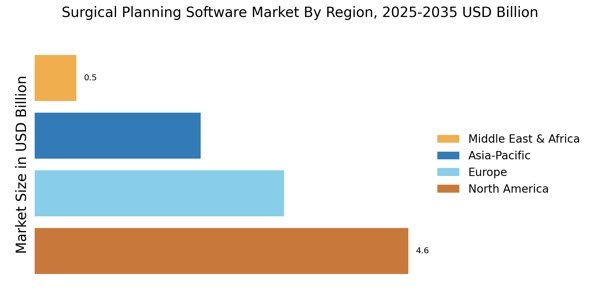Increasing Focus on Surgical Efficiency
The Surgical Planning Software Market is witnessing a growing emphasis on surgical efficiency. Healthcare institutions are increasingly prioritizing the optimization of surgical workflows to reduce operation times and enhance resource utilization. Surgical planning software plays a crucial role in streamlining preoperative processes, allowing for better scheduling, resource allocation, and team coordination. Data indicates that hospitals implementing such software have reported significant reductions in surgical delays and improved patient throughput. As the healthcare sector continues to seek ways to enhance operational efficiency, the demand for surgical planning software that supports these objectives is expected to rise, thereby bolstering the Surgical Planning Software Market.
Rising Demand for Personalized Medicine
The Surgical Planning Software Market is experiencing a notable increase in demand for personalized medicine. This trend is driven by advancements in genomics and biotechnology, which enable tailored surgical approaches based on individual patient profiles. As healthcare providers seek to enhance patient outcomes, the integration of surgical planning software that accommodates personalized treatment plans becomes essential. According to recent data, the market for personalized medicine is projected to reach substantial figures, indicating a shift towards more customized healthcare solutions. This evolution necessitates sophisticated software that can analyze complex data and provide actionable insights, thereby propelling the growth of the Surgical Planning Software Market.
Technological Advancements in Imaging Techniques
Technological advancements in imaging techniques are significantly influencing the Surgical Planning Software Market. Innovations such as 3D imaging, augmented reality, and advanced visualization tools are enhancing the precision of surgical planning. These technologies allow surgeons to visualize anatomical structures in unprecedented detail, thereby improving preoperative assessments and surgical outcomes. The market for imaging technologies is expected to grow, with estimates suggesting a compound annual growth rate that reflects the increasing reliance on advanced imaging in surgical procedures. Consequently, surgical planning software that integrates these cutting-edge imaging techniques is likely to see heightened demand, further driving the Surgical Planning Software Market.
Growing Adoption of Telemedicine and Remote Surgery
The Surgical Planning Software Market is being propelled by the growing adoption of telemedicine and remote surgery. As healthcare systems evolve, the need for effective surgical planning tools that facilitate remote consultations and procedures is becoming increasingly apparent. Surgical planning software that supports telemedicine applications allows surgeons to collaborate with specialists across distances, enhancing the quality of care provided to patients. Market data suggests that the telemedicine sector is expanding rapidly, with projections indicating substantial growth in the coming years. This trend underscores the necessity for surgical planning software that can seamlessly integrate with telemedicine platforms, thereby driving the Surgical Planning Software Market forward.
Regulatory Support for Advanced Surgical Technologies
Regulatory support for advanced surgical technologies is a key driver of the Surgical Planning Software Market. Governments and regulatory bodies are increasingly recognizing the importance of innovative surgical solutions that improve patient care. Initiatives aimed at expediting the approval process for advanced surgical technologies are likely to encourage the development and adoption of surgical planning software. This regulatory environment fosters innovation and investment in the sector, as companies are more inclined to develop cutting-edge solutions that comply with evolving standards. As a result, the Surgical Planning Software Market is poised for growth, driven by favorable regulatory conditions that support technological advancements.


















Leave a Comment